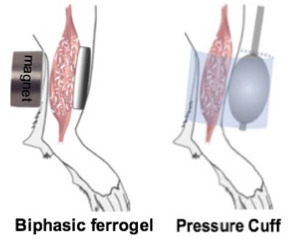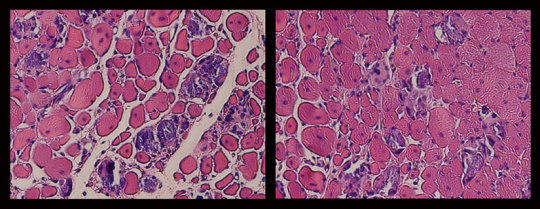For patients with severely damaged skeletal muscles, the best way to heal them is a combination of splinting and physical therapy, right? These serve to increase the size of existing muscle fibers. And a few cellular therapies are also available involving stem cells or stimulating their production, which may actually add new muscle. But what about something cheaper and less complicated?
Researchers at the engineering school at Harvard are working on a new approach, mechanotherapy. They tried two therapeutic interventions in mice with hindleg muscle damage and ischemia.
The first was implantation of a magnetic gel pack directly in contact with the muscle. A magnet placed on the other side of the muscle was pulsed to repeatedly squeeze the muscle gently.
The second group had a small pneumatic cuff placed which encircled the leg (a tiny mouse BP cuff?). If was inflated cyclically to massage the muscle.

Both therapies resulted in a 2.5x increase in muscle regeneration and less scarring and fibrosis, compared to control animals that had neither therapy.

Left image: control animal. Right image: mechanotherapy. Note the increased muscle cell density.
Bottom line: Unfortunately, we typically think about medicine from a chemical standpoint. That’s why we are so reliant on drugs for just about everything. But this study suggests that merely squeezing the muscle regularly and early after injury may greatly improve healing. There are significant implications for trauma patients, of course. Might it also be possible to help decrease muscle mass loss in denervated muscles, as in para- and quadriplegics? And we may find that if we combine this with some of the biologics already in use, the results may be even better. Stay tuned for developments.
Related post:
Reference: Biologic-free mechanically induced muscle regeneration. Proc Natl Acad Sci USA 113(6):1534-1539, 2016.

